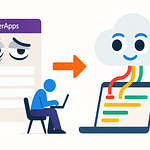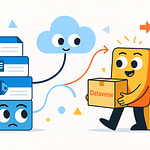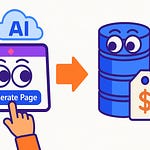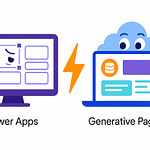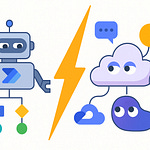The Myth of “Low-Code for Everyone”
Most people think Power Apps is about dragging buttons onto screens until something vaguely resembling an app appears. Click, drag, publish—done. Wrong. That’s the fairy tale version Microsoft marketed to “empower everyone,” and it worked—too well. Because now, there’s a new species loose in the ecosystem: Vibe Code. That’s the evolution where Power Apps meets serious development. Equal parts JavaScript, Git discipline, and AI-assisted chaos.
See, Power Apps started as a playground for business users: citizen developers armed with enthusiasm and questionable naming conventions. The dream was simple—“Build your own app without writing code.” And yes, you could whip up a form faster than it takes IT to say “governance policy.” But somewhere between the fifth nested formula in Power Fx and the third unexplained delegation warning, the dream cracked.
Enter the schism: citizen devs versus professional devs. On one side, the drag-and-drop romantics who swear by speed and flexibility. On the other, the pro coders who look at Canvas App formulas and feel a deep, existential dread. One group lives for instant results; the other demands reusable components, source control, and environments that don’t break when someone renames a field.
Now, Code Apps—or as I prefer, Vibe Code—bring that missing discipline back. They let you use Visual Studio Code, proper frameworks like React, and still live inside the Power Platform’s luxurious, compliance-approved walled garden. It’s not rebellion; it’s a truce between creativity and control.
By the end of this, you’ll know exactly when Vibe Code wins, when Low-Code saves the day, and how GitHub Copilot glues the two worlds together faster than any junior dev could. We’re about to unpack the illusion of simplicity, the metrics of scale, and the AI that’s pulling the strings between both worlds. So forget everything you think you know about Power Apps—because “low-code for everyone” was never the real story. It was just the prologue.
Section 1: The Low-Code Illusion
Low-Code sold a convenient fantasy: anyone could be a developer. That sounds noble until you realize “anyone” includes Gary from accounting, who just built an app that performs twenty SQL queries every five seconds. The promise was empowerment. The result? Syntax chaos disguised behind pastel-colored buttons.
Let’s demystify it. Power Apps comes in two main flavors: Canvas and Model-Driven. Canvas Apps are the design-your-own interface kind—freedom incarnate. You drag components onto a blank canvas, wire them up with Power Fx, and feel like Picasso with an API. Model-Driven Apps, however, are the rule-followers. They take your Dataverse tables and automatically generate UI like a disciplined robot. They’re structured, but rigid—perfect for data-heavy use cases, less so for anything that demands flair.
Now, what both share is speed. You can prototype in hours, sometimes minutes. That’s the dopamine hit Microsoft built this empire on. Business units didn’t need IT approval anymore; they could “empower” themselves. But the hidden cost came later—maintenance nightmares that grew like invasive plants across the enterprise. Because Low-Code doesn’t mean low complexity. It just hides that complexity behind cheerful names and mouse clicks.
Take Power Fx, for example. It looks harmless—a little Excel-inspired formula language for app logic. But under the hood, it creates sprawling dependency webs that only the original creator can untangle. Lose that person, and you lose the logic. Governance tools can help, sure, but most organizations end up with dozens of variations of the same “Task Tracker” app, all slightly broken in unique, fascinating ways.
The analogy is inevitable: Low-Code is IKEA furniture. Assemble it fast, feel competent, and then realize you don’t know where that extra bolt came from. Heaven help you if you ever need to move it or upgrade it—because there’s always missing documentation and a mystery hex key involved.
Departments hit the tipping point the moment they want serious integrations: SQL backends, Git repositories, automated pipelines. Canvas Apps weren’t designed for that depth. They shine for quick process tools—leave requests, status dashboards—but not full production-grade systems that must survive audits, scaling, and developer turnover. That’s when teams face the “rewrite moment,” where Low-Code’s convenience suddenly becomes its cost.
So, Microsoft did something smart. Instead of pretending the problem didn’t exist, they equipped developers with a new way to take back structure without abandoning the platform’s benefits. And thus, Vibe Code entered the chat—a form of Power Apps that behaves like a modern web project but still enjoys all the comforts of enterprise governance, connectors, and authentication.
What’s coming next flips the script entirely. Because where Low-Code abstracted complexity away, Code Apps embrace it—on your terms. This isn’t rebellion for its own sake. It’s infrastructure therapy, delivered through syntax.
Section 2: Enter Vibe Code (Power Apps Code Apps)
Now we come to the grown-up table. Vibe Code, or what Microsoft humbly calls “Power Apps Code Apps,” is what happens when the Power Platform finally admits it’s part of the developer family again. Gone are the days of pastel interfaces and formula boxes; this is React in a suit and tie, hosted inside Power Apps. Think of it as a high-end condominium inside the same gated community, but this unit has stainless steel appliances and version control.
Here’s the simple version: Code Apps are full-fledged React web applications that run inside the Power Platform. Yes, inside. You write in your favorite IDE—Visual Studio Code—using all the modern trimmings: Node.js, TypeScript, .NET, and Git. The Power Platform gives you structure, connectors, and security; React gives you raw creative control. It’s the best of custom and controlled worlds—the artistry of a full-stack dev inside Microsoft’s carefully monitored walled garden.
Let’s decode the workflow. It starts at the command line, where developers feel most alive. You initialize a Code App using the Power Platform CLI—a tool that connects your local project directly to your Power Platform environment. Then, with a few commands like pac code init, you bootstrap a standard React project, configure your power.config.json, and link it to your environment. This is the digital equivalent of setting up residency: your local machine meets the cloud—and shakes hands politely through authentication.
From there, you bring in connectors. Power Apps supports over 1,500 of them: SharePoint, SQL, Office 365, ServiceNow, Azure, and more. Add these directly into your app using the CLI, and a new TypeScript service pops up like it was always meant to be there. No silly formula matching, no nested conditional statements pretending to be logic. It’s just code. Predictable, readable, testable.
If Low-Code was LEGO—you build from what you’re given—then Code Apps is the 3D printer that fabricates your own bricks. You’re not confined to prefab shapes; you’re sculpting your own UI, logic, and components. That’s why Pro-Coders love this world: it’s still the Power Platform, but it respects their intelligence.
Imagine this lifecycle: open VS Code, type away, test locally on your machine with npm run dev, fix, test again—and when satisfied, push the app to Power Apps with one command: pac code push. Moments later, your React app appears alongside standard Canvas Apps within your environment, inherits all the environment’s governance policies, and—crucially—authenticates automatically using Microsoft Entra. You’re still compliant with organizational rules, but now you can finally write your own logic without fighting abstraction layers.
The real joy isn’t just the technology—it’s the structure. Source control through Git becomes standard; collaboration through pull requests becomes possible; CI/CD pipelines become trivial. Every software engineer who’s ever cried over a corrupted Power Fx formula can now relax. Versioning isn’t a dream—it’s baseline reality.
And yet, Microsoft knew this wasn’t enough. Even though Code Apps made real code first-class citizens again, productivity was still bottlenecked by the same thing that plagues every dev shop: repetition. Type imports, connector calls, data mappings—all boilerplate. Powerful, yes, but tedious. Which is why the next piece of the puzzle isn’t another framework or SDK—it’s something far more intoxicating: artificial intelligence. Microsoft didn’t just bring back structure; it brought a sidekick. The next era of Power Apps development starts with a line we never thought we’d say: “GitHub Copilot, build this for me.”
Section 3: GitHub Copilot—The Vibe Partner
Now, let’s talk about the intern no one paid for but everyone relies on: GitHub Copilot. You could call it autocomplete on caffeine, but that undersells what it’s doing for Power Apps developers. In this new Vibe Code world, Copilot isn’t just a helper—it’s a silent collaborator, one who writes entire sections of code before your brain’s had time to catch up.
Let’s establish boundaries first. Copilot doesn’t create strategy—it composes syntax. You, the developer, define what needs to exist: a dashboard, a form, a data pull from SharePoint. Copilot handles the grunt work: scaffolding components, writing JSX, fetching data, fixing build errors, streamlining imports. It remembers your context across the session, so by the time you say, “Add a profile card that shows user name, email, and photo,” it’s already typing. You watch React components assemble themselves in real time, and for one brief second, you think maybe Skynet deserves forgiveness.
This is the power amplification layer that transforms good developers into fast ones. Suddenly, Code Apps development moves at startup velocity. Need to hook into Dataverse? Type one comment and Copilot spits out a full service interface wired to your connection. Want to display a SharePoint list as a Kanban board? Ask politely, and within seconds you’ve got draggable swimlanes powered by modern React state management. Efficiency that used to take a sprint now takes a coffee.
The analogy writes itself: Copilot isn’t your creative director; it’s the intern who never sleeps, types 120 words per minute, and doesn’t complain about documentation. It fills in the blanks while you guide the architecture. And when you test and iterate, it learns patterns from your prompts, becoming eerily good at predicting your next component or data model. It’s not “AI replaces programmers.” It’s “AI removes the typing part of programming,” which, let’s face it, is the boring part anyway.
But before you start deploying blindly, here’s the serious note. Copilot accelerates syntax, not semantics. It can write error-free code that’s conceptually wrong if you’re not watching. That’s why discipline—reviews, testing, source control—matters more than ever. Let Copilot generate; you validate. That partnership, not automation, is the smart developer’s advantage.
When this dynamic plays out inside the Power Platform, something magical—and pragmatic—happens. Enterprises suddenly gain the speed of citizen development with the integrity of professional code. Business users get their features faster, IT gets its governance, and developers get out of the swamp of repetitive front-end plumbing. Everybody wins, including Microsoft’s server utilization metrics.
The net effect: Power Apps Code Apps, powered by Copilot, feel less like systems development and more like orchestrating intelligence. You describe intentions; the machine translates them into running code—all within a governed environment with secure authentication and managed connectors.
So now both worlds—Low-Code and Vibe Code—are in full motion: one democratizing creation, the other formalizing scale. But which one should drive your next project? That’s the question professionals are about to ask in every strategy meeting. Because we’ve tasted both speed and structure—and we’re not going back. The next section decides the winner.
Section 4: Vibe Code vs. Low-Code—Choosing Your Weapon
Here’s where the philosophical turns practical. Low-Code and Vibe Code aren’t moral choices—they’re strategic ones. Both sound enticing: one gives anyone the illusion of instant productivity, the other offers precise control and a faint whiff of superiority. The truth? You need to know when speed matters more than architecture, and when governance beats enthusiasm. Because whether you’re orchestrating a single workflow or a platform portfolio, your weapon defines your outcome.
Start with development workflow. Low-Code feels friendly because it’s graphical. You drag, configure, and get that satisfying spark when something actually works. No syntax errors, no failed builds, just a functioning form. But what you gain in approachability, you lose in reusability. Components can’t easily travel between apps; refactoring means opening interfaces one by one; debugging feels like deciphering hieroglyphs. Vibe Code, in contrast, trades ease for power. You live in Visual Studio Code, the CLI is your home, and Git is your safety net. You structure your codebase, share modules between apps, and automate everything from build to deploy. The GUI devotees may call it overkill. Engineers call it Tuesday.
Governance is where the gap widens into a canyon. Low-Code operates within Power Platform environments—useful for departmental scalability but bound by whatever DLP and data boundary policies the admins install. Great for insulation, not great for orchestration. Code Apps, on the other hand, sync directly with DevOps pipelines. You can enforce pull request approvals, automated testing, linting, even semantic versioning. That’s not bureaucracy—it’s survival when multiple teams are shipping changes weekly. Governance becomes a feature, not a complaint.
Performance follows the same pattern. In Low-Code, abstraction protects you but also handcuffs you. Every button press runs through layers of the Power Fx interpreter, then into connector middleware, then finally to the data source. Efficient enough for most business use cases, yes. But if you need real-time dashboards, dynamic rendering, or high-volume processing, those invisible layers turn into molasses. Code Apps shed the fat. React handles state in the browser; JavaScript calls connectors directly through SDK; rendering is immediate. It’s like comparing a high-level language lesson to a live circuit demonstration—the latter sparks faster, and you can actually see the current.
Security isn’t as divisive as people assume. Both worlds live under Microsoft Entra authentication. Both obey Conditional Access, encryption, and tenant boundaries. The nuance is granularity. Low-Code enforces security through configuration—checkboxes, role tables, and access lists. Fine for most tasks, limiting for anything nuanced. Code Apps bake in security logic right inside your code: role validation at runtime, custom API calls with token handling, dynamic permission-based UI. In other words, you can make the app itself smart enough to know who’s poking around. That level of control matters when “who clicked what” could be an audit question, not just a metric.
Maintenance is the quiet killer. Low-Code wins at inception—an app built in hours—but eventually collapses under its own shortcuts. Connectors get deprecated, controls change behavior, formulas break when data types evolve. Each fix is manual because the “code” isn’t really text; it’s configuration. Meanwhile, Code Apps live and die by Git commits. You can branch, merge, roll back, and recompile. When Microsoft changes SDK versions, you update your packages and rebuild, not rewire everything manually. Longevity favors code, not convenience.
Then there’s team alignment. If your builders are business analysts who know processes but hate syntax, Low-Code is the natural arena. They understand what needs doing and thrive in a system that abstracts the details. But once you involve developers—those who speak JSON fluently and scoff at drag‑and‑drop—forcing them into Canvas Apps is like asking a surgeon to operate with mittens. Give them the keyboard, the CLI, and the repository, and they’ll deliver something maintainable rather than mystical.
Let’s ground this in miniature reality checks. Suppose the HR department wants a tool that automates employee onboarding right from a SharePoint list: triggers emails, updates Dataverse rows, flags IT tasks. That’s a perfect Low-Code play. Fast, functional, self-contained, low risk. Now picture a manufacturing division needing a system that pulls data from SQL, external APIs, and IoT telemetry, with customized charts and responsive dashboards. That’s not a Canvas problem—that’s a Code App destiny. Low-Code can imitate such complexity, but at the cost of maintainability. Vibe Code starts there naturally.
Here’s where it gets amusing: despite the power gap, Low-Code isn’t disappearing. It’s mutating. The future isn’t a coup where developers overthrow citizen creators; it’s a coalition. Hybrid builds already exist—Canvas Apps embedding custom React components, Code Apps consuming connectors originally configured in Low-Code. Think of it as distributed intelligence: one side prototypes ideas quickly, the other scales them properly. When both coexist, the entire Power Platform transforms from tooling chaos to a cohesive development ecosystem.
And yes, there’s irony. The platform built to eliminate code now depends on it again—but elegantly, with AI accelerating both sides. Vibe Code doesn’t declare war on Low-Code; it offers an exit from its limitations while keeping the ease that made it popular in the first place. Canvas empowers creativity. Code ensures continuity. Together, they form a closed loop of innovation and governance—Microsoft’s favorite love story.
When you start viewing Power Platform this way, debates about “which one’s better” sound childish. A hammer isn’t better than a wrench; they’re just different tools for different bolts. The real skill is knowing when you need fine torque or blunt impact. The best architects design systems that mix both—quick prototypes through Low-Code, hardened modules through Vibe Code, all wrapped by Copilot’s AI suggestions humming like quiet machinery behind the scenes.
That’s the equilibrium professionals are heading toward: rapid ideation married to disciplined execution. The platform isn’t bifurcating; it’s specializing. So before you pick sides, remember—the weapon doesn’t make the warrior. It just makes their job faster, cleaner, and, in the case of Power Apps, significantly more compliant.
Section 5: The Strategic Layer—AI, Governance, and the Future of Power Platform
Here’s the part most people miss: Microsoft isn’t staging a coding war. It’s engineering a merger. The Power Platform’s future isn’t “Low-Code versus Pro-Code.” It’s the unification of both underneath a shared governance and AI-driven architecture—a single nervous system that connects every creative impulse to enterprise-grade control. Think of it less like two camps and more like one ecosystem learning to self-regulate.
The “strategic layer” is where this evolution becomes visible. At a technical level, everything’s converging around three pillars: Copilot, Dataverse, and governed extensibility. Copilot Studio now writes connectors that previously required manual SDK calls. Code Components—the tech that lets React or TypeScript controls run inside Canvas Apps—are dissolving the wall between citizen and professional creation. And Dataverse—the central data service once reserved for model‑driven purists—is now the ground both camps stand on. It provides the schema, security, and relationship logic that make all these disparate bits behave like one organism.
Picture the platform as a living body. The citizen developers are its cells—rapidly generating new tissue: dashboards, forms, workflows. The developers are the neurons—linking those cells together, refining reflexes, ensuring the organism thinks before it moves. Governance, meanwhile, acts as the immune system, preventing rogue cells from spawning unapproved connectors or violating data policies. Add AI, and suddenly that body starts predicting rather than merely reacting to business needs.
From a business perspective, this is gold. It standardizes deployment pipelines so that every app—whether built by marketing or engineering—travels through the same CI/CD arteries. It centralizes monitoring, security, and compliance while preserving creative autonomy. Citizen devs get to experiment; IT gets traceability; leadership gets measurable ROI. Everyone’s incentives align, finally, under one architecture instead of fighting over tooling.
The AI layer cements this truce. Copilot doesn’t favor coders or citizens—it interprets both. To the business user, it feels like natural language magic: “Build me a project tracker” results in an instant Canvas skeleton, Dataverse table, and basic logic. To the developer, the same engine offers code suggestions, connector templates, and function scaffolds that would otherwise eat hours. It’s two dialects—English and JavaScript—spoken through one interpreter that never sleeps.
There’s a term for what’s forming: governed expressiveness. It’s no longer about who can code; it’s about how efficiently each person can express intent and how safely that intent is deployed. Microsoft’s architecture quietly enforces this balance through policies, environment segmentation, and now Copilot‑augmented guidance baked directly into the IDE. It’s democratization without entropy.
The near future looks less like “no code versus full code” and more like a spectrum of expressiveness per citizen. Someone building in Excel might graduate to Power Fx; a Power Fx user might evolve into writing TypeScript components; and a pro dev might prototype new features in Low‑Code before hardening them in React. It’s a circular ladder that keeps everyone contributing at their comfort level without breaking the ecosystem.
This is what “Vibe Coding” actually signals. It’s not just writing code with flair; it’s coding that feels like Low‑Code—fast, iterative, assisted by AI—but scales like Pro‑Code. Environments sync to Git. Pipelines validate deployments. Copilot teaches best practices invisibly. The experience smooths into one continuous motion between thinking and building. In effect, Power Platform becomes a composable brain—absorbing new patterns from every user, whether they drag components or refactor functions.
That’s the strategic horizon: an enterprise platform behaving like collective intelligence. When you see it that way, the “Vibe” in Vibe Code stops sounding mystical. It’s the resonance between freedom and discipline, between human creativity and machine governance. And when those vibrations align, the whole system hums.
Conclusion: The Real Truth
Here’s the truth stripped of slogans. Power Apps Vibe Code isn’t killing Low‑Code; it’s correcting its excesses. It’s the gentle realization that unlimited “citizen freedom” without rules turns into messes only pro devs can mop up. Vibe Code returns structure, visibility, and maintainability—without dismantling the empowerment that made Low‑Code succeed in the first place.
So use Low‑Code for velocity. Spin up prototypes, validate ideas, prove concepts. Then expand them using Vibe Code for longevity: versioned components, real frameworks, automated deployment. And through it all, let GitHub Copilot unify both worlds—your silent translator between business logic and technical syntax. The moment you treat AI as the bridge, not the replacement, you start developing at the speed of thought and the discipline of engineering.
The Power Platform isn’t splitting apart; it’s evolving toward composable intelligence—where every workflow, app, and connector plugs into a shared mental model of the organization. That’s the real transformation: not faster forms, but smarter systems that learn from how you build.
If that vision saves you time—or spares you another governance post‑mortem—repay the favor. Subscribe, tap “Follow,” and let the next deep dive arrive automatically, like a scheduled Power Automate flow. Knowledge should update itself. Proceed.





